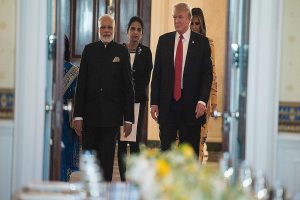In a glaring indicator of the growing tensions in India’s immediate neighbourhood, it has now emerged that there were a whopping 11,424 Ceasefire violations (CFVs) on the border under the seven years of the NDA government, compared with just 523 CFVs during the UPA’s 10-year rule.
Year-wise, the border infringements shot up astronomically from just 1 in 2004 to a staggering 4,645 in 2020 – or a rough daily average of 13 – a year after India’s sensational air-strikes in Balakot (Feb. 2019) and the country acquired a sleek fleet of Rafale fighter jets. (July 2020).
Advertisement
As per RTI replies given to Pune-based activist Prafful Sarda, the revelations largely pertain to the CFVs along the India-Pakistan borders (LoC), which has always been a super-sensitive issue with India.
However, the government has categorically refused to divulge details of CFVs on the India-China borders (LAC) including specific details of the Doklam incidents, under RTI Act, 2005, Sec. 8(1) (a), in the replies furnished by Brig. V. K. Bhat, CPIO, Indian Army Headquarters,
“The government ostensibly feels such disclosures could affect India’s sovereignty and integrity, her security, strategic, scientific or economic interests, relation with foreign state, etc,” Sarda told IANS.
The RTI replies reveal how during the UPA government of Prime Minister Manmohan Singh between 2004-2013, there were a total 523 CFVs on the border, starting with just one in 2004, 6 the next year and 3 the following year.
The CFVs entered the double-digit and kept fluctuating with ups and downs, starting with 21 in 2007, jumping to 77 in 2008, down to 28 in 2009, spelling relief.
From then, there was no looking down and the CFVs kept soaring each year, starting with 44 in 2010, 51 (2011), 93 (2012), and 199 in 2013, almost till the end of the UPA government’s second term.
In the Bharatiya Janata Party-led NDA’s first couple of years, things appeared bright with CFVs dropping from 199 the previous year (2013) to 153 in 2014 and 152 (2015).
After Prime Minister Narendra Modi’s unscheduled trip to greet former Pakistan PM Nawaz Sharif for his birthday on Dec. 2015, things were expected to improve further, but in 2016, there were 228 CFVs…!
The following year, 2017, when Nirmala Sitharaman became the Defence Minister the borders became hyperactive and the year saw 860 CFVs.
That was nearly four times compared with 228 in 2016 – when Pakistan rattled India with the Uri attacks and India retaliated with the ‘surgical strikes’ in Pakistan Occupied Kashmir (POK) in September that year.
The CFVs became almost twice, going up to 1,629 in 2018 and again nearly doubled to 3,233 in 2019, but as the NDA 2.0 settled into its second term, there were 4,645 CFVs in 2020 with Rajnath Singh helming the Defence Ministry.
“As per the RTI replies, from 2004 till 2021, there were a total of 11,947 border skirmishes of which only 523 were between 2004-2013. In the past 7 years from 2014-2020, there were a stupendous 11,424 CFVs, including 524 in the first two months of 2021,” Sarda pointed out.
India-Pakistan had first agreed to CFVs in 2003 and implement a truce along their de-facto border along the erstwhile state of Jammu & Kashmir.
Interestingly, Union Minister of State for Home G. K. Reddy informed the Lok Sabha in a written reply in Feb. 2021 that there were 2,140 CFVs in 2018, 3,479 in 2019 and 5,133 CFVs last year, when the country was enveloped under the Coronavirus pandemic and mostly remained under lockdown.
Reddy further stated that in those three years (2018, 2019, 2020), a total of 70 civilians and 72 security personnel were killed due to the CFVs.
“It appears that the number of CFVs have not decline since 2016, but the Indian defence forces are ever alert and fully geared to the border challenges with all forward posts along the LoC adequately strengthened to withstand enemy fire,” said Sarda.
The RTI reply added that there are well-established SOPs to safeguard against enemy action along the LoC and minimize own (Indian) casualties, all infringements by Pakistani troops are retaliated appropriately, and raised with their top military authorities through established mechanisms of “hotline and flag meetings”.
“These violations are also taken up through diplomatic channels by MEA with Pakistan to put pressure to cease such violations and maintain peace and tranquility along the LoC,” the government stated.











